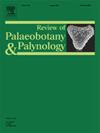Ilex subg. Prinos (Aquifoliaceae) from the upper Miocene of Beihai, low-latitude China: New insights for phylogeny
IF 1.7
3区 地球科学
Q2 PALEONTOLOGY
引用次数: 0
Abstract
The holly family (Aquifoliaceae) is a monogeneric taxon comprising highly diverse species of Ilex (> 600 species), predominantly distributed in warm, humid regions. However, the phylogeny of Ilex and the evolutionary differentiation of its subgenera, i.e., Ilex subg. Ilex, I. subg. Prinos, and I. subg. Byronia, remain challenging partly due to limited fossil constraints of each subgenus. Previous phylogenetic study was only anchored by the of Ilex subg. Ilex, which is not sufficient to calibrate the differentiation of all subgenera. Here, we report the fossil leaves of Ilex subg. Prinos from the late Miocene Foluo Formation of Beihai, Guangxi, low-latitude China. The fossils are characterized by elliptic leaf in shape with slight serrations on the leaf margin except for the leaf base. The venation is pinnate with secondary veins of 7–8 pairs, while the tertiaries are mixed percurrent. Anatomically, the leaves are hypostomatic with wart-like structures and cyclocytic stomata. Importantly, the anticlinal walls are straight in both upper and lower epidermises. This is the earliest known fossil Ilex subg. Prinos so far, providing a new insight for molecular clock analyses.
冬青属植物subg。中国低纬度北海中新世上部水仙花属:系统发育的新认识
冬青科是冬青属的一个单属分类单元,由高度多样化的冬青种组成(约600种),主要分布在温暖潮湿的地区。然而,对冬青的系统发育及其亚属(即冬青亚属)的进化分化进行了研究。Ilex, i, subg。普林诺斯和我。由于每个亚属的化石限制有限,拜伦亚属仍然具有挑战性。以往的系统发育研究仅以冬青亚群为基础。这不足以校准所有亚属的分化。本文报道了冬青属植物的叶化石。中国低纬度广西北海晚中新世洛罗组中的巨象。叶形椭圆形,除叶基外叶缘有轻微锯齿。脉脉为羽状,次生脉7 ~ 8对,三级脉为混流脉。解剖上,叶下气孔,有疣状结构和环状气孔。重要的是,背斜壁在上下表皮上都是直的。这是已知最早的冬青亚属化石。到目前为止,为分子钟分析提供了新的见解。
本文章由计算机程序翻译,如有差异,请以英文原文为准。
求助全文
约1分钟内获得全文
求助全文
来源期刊
CiteScore
3.50
自引率
21.10%
发文量
149
审稿时长
6 months
期刊介绍:
The Review of Palaeobotany and Palynology is an international journal for articles in all fields of palaeobotany and palynology dealing with all groups, ranging from marine palynomorphs to higher land plants. Original contributions and comprehensive review papers should appeal to an international audience. Typical topics include but are not restricted to systematics, evolution, palaeobiology, palaeoecology, biostratigraphy, biochronology, palaeoclimatology, paleogeography, taphonomy, palaeoenvironmental reconstructions, vegetation history, and practical applications of palaeobotany and palynology, e.g. in coal and petroleum geology and archaeology. The journal especially encourages the publication of articles in which palaeobotany and palynology are applied for solving fundamental geological and biological problems as well as innovative and interdisciplinary approaches.

 求助内容:
求助内容: 应助结果提醒方式:
应助结果提醒方式:


